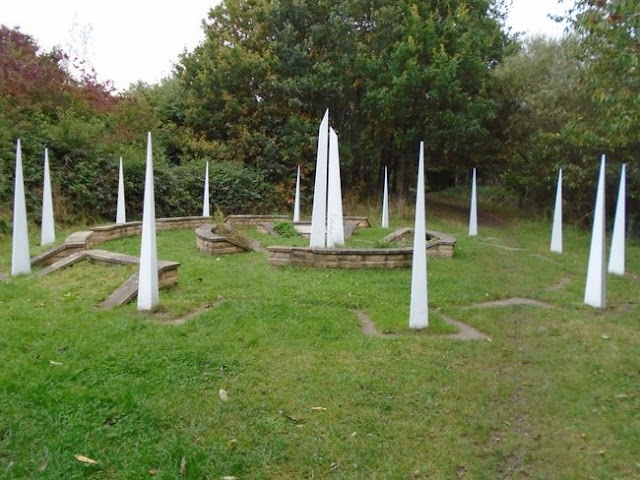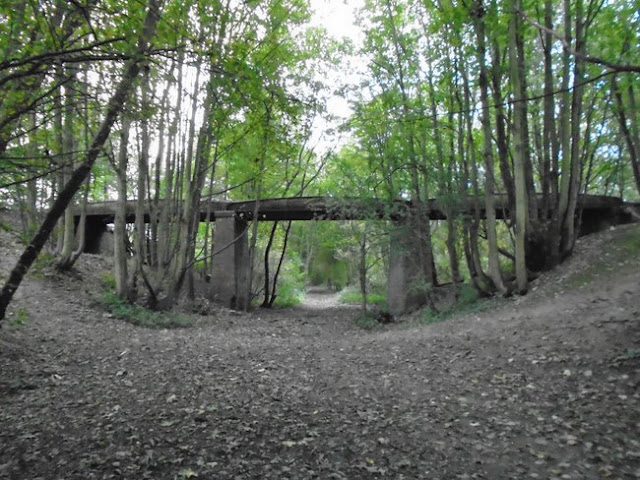Starting Point - Sandal and Agbrigg station. Finishing Point - Goldthorpe Station. Distance - 14 Miles.
Above - An ex War Department loco hauls a coal train north through Grimethorpe Halt in 1951 shortly before passenger services ceased. The halt itself was just an area out of shot at the foot of the bridge the photo was taken from where passengers could board the single coach train. Photo by Ben Brooksbank from Wikimedia Commons.
The Dearne Valley Railway was built to serve several collieries and connect a number of lines in the area of the Dearne Valley between Wakefield and Doncaster. Though built by an independent company the line was operated by the Lancashire & Yorkshire Railway from its opening in 1902 and subsequently by the London Midland and Scottish Railway and British Railways. Though primarily built for coal traffic a passenger service was operated between 1912 and 1951 initially using a single coach steam railmotor and later using push pull trains. Most of the route closed in 1966 but remnants continued in use to serve Goldthorpe Colliery and Yorkshire Main Colliery. Some of the chords built to connect to other lines south of Doncaster remain in use as part of a flying junction to separate freight and passenger lines that was built after the DVR closed but used some of the surviving infastructure. This walk was done over two days, breaking the journey at Goldthorpe. More about the history can be read on the Wikipedia article.
Google Map. This unfortunately doesn't show directions to follow the course of the railway, I also used Open Street Map to check out the right of way status of the former trackbed.
The route began at Crofton West Junction to the south east of Wakefield. The nearest railway station in use today is Sandal and Agbrigg on the local services between Leeds and Sheffield or Doncaster. Looking at the old map above reveals a maze of railway lines and I begin the walk by walking the Sandal Curve which once linked the Great Northern Railway and Midland Railway, the path begins at the end of the station carpark. It leads to Oakenshaw Lane, just before the former junction with the Midland line.
Below - Former "Sandal Curve" chord from the former GNR at Sandal and Agbrigg to the Midland line.
Below - Bridge carrying the former Sandle Curve. the embankment of the Midland line can be seen under the bridge, now just used as a single track freight branch to a glass works at Monk Bretton.
Below - Bridge carrying the former Midland line to Sheffield over the GNR.
Walton Colliery Nature Park has been established on the site of Sharlston West Colliery. I followed paths through the nature reserve to the northern edge of the park where a footpath can be seen crossing under the LNER's Crofton Branch from Oakenshaw Beck on the old map.
Below - Henry Daley Memorial dedicated to a local councillor.
The footpath had originally continued under Crofton West Junction but I found it to be fenced off, even though still shown as a footpath on Open Street Maps.
Below - Fenced off footpath bridge under the site of Crofton West Junction and the surviving Wakefield to Knottingley line.
There was a well trodden path up the embankment of the former Dearne Valley line that I followed, though somewhat weary about where it emerged in relation to the active railway. This is not shown as a footpath so it would probably be more sensible to pick up the trackbed at the site of Crofton South Junction at Shay Lane if planning on visiting the route.
Below - Former sewage works access under Crofton East Fork.
Interestingly this bridge has had the embankment removed behind the abutments revealing interesting detail of the bridge's construction.
I emerged on the road from the sewage works and on to Shay Lane at the site of Crofton South Junction, which is now occupied by a caravan storage facility.
The large cutting that once contained Crofton Hall Sidings has now been filled in and now contains sports fields and a children's play area. A footpath runs through the site to Hare Park Lane where the bridge survives but the trackbed has been filled in up to the bridge deck.
Below - Filled in Hare Park Lane bridge
The bridge over the former Great Northern line has been removed, the abutments of it can still be seen from passing trains. This means there is a detour through the streets of Crofton to pick up the line again at Santingley Lane.
Below - Crofton Colliery memorial on the corner of Spring Lane and Santingley Lane.
Below - Santingley Lane bridge, from here a path occupies the trackbed.
Below - Filled in farm access bridge for Santingley Grange.
Below - Remains of what seems to have been the milepost shown on the old map.
The Dearne Valley line crossed over the Stairfoot & Nostell line, previously known as the Barnsley Coal Railway of the South Yorkshire Railway and later the Great Central Railway. I have previously done a walk of this route. The bridge has been removed and the path descends to the level of the Barnsley Coal Railway where it crosses the path along it before climbing back up the embankment. Bridges have also been removed over Back Lane and Swine Lane so while the embankment survives there is little engineering work of the line to be seen until Ryhil.
The cutting through Ryhill has been filled in, though the path follows the course of the route. There is also no sign of Cow Lane bridge. Between Cow Lane and Brier Lane the path detours around the east side of the trackbed. The cutting has been filled in at Brier Lane bridge too but the bridge can still be seen.
Below - Filled in Brier Lane bridge
Brier Lane once provided access to Ryhill Halt. The path that accessed the southbound platform is now the path that continues along the course of the railway. The entrance to the path down to the northbound platform has been sealed off with railway sleepers, perhaps this dates back to passenger services ending in 1951?
When I say platform, the stations on the Dearne Valley Railway were in fact very primitive with at most a hard standing of railway sleepers rather than platforms, passengers had to use the steps on the railmotor or coaches to climb up in to the carriage.
Below - Trackbed at the site of Ryhill Halt looking north.
After Ryhill the path descends back to track level from the filled in cutting and a small wooded area known as Cawker Wood contains a couple of interesting remnants of the line.
Below - Former farm access bridge.
Next is the former Colliery tramway to New Monkton Colliery. In part the tramway pre-dated the railway and when the Dearne Valley Railway was built a simple bridge with three cast iron spans was built over the railway. The 1893 map shows the tramway previously running in to a tunnel.
Below - Former New Monkton Colliery tramway bridge.
A footpath follows the tramway to Church Lane, though unfortunately I found that the viaduct shown on the old map had been demolished. The viaduct would have also been built in the early 1900s when the tramway was extended over the new line.
Below - A fishplate seen in Cawker Wood.
Below - Kirkgate Lane bridge.
The path crosses Hemp Dyke on a small footbridge, here the Dearne Valley Railway crossed over the Hull and Barnsley Railway though the bridge has been removed and the embankments leading up to it removed. The path runs along the east side of the trackbed, though I did find the trackbed itself could be followed through the cutting and under Blacker Lane bridge.
Below - Blacker Lane bridge.
The vegetation was quite thick and I missed any trace there might have been of Shafton Junction where a chord linked the DVR with the H&BR in the Hull direction. Open Street Map showed the footpath ending at the roundabout with Brierley Road and Southgate at the site of the tunnel mouth. In reality I should probably have emerged on to one of the residential streets north of here. The approach to the tunnel was quite overgrown and the tunnel itself filled in, it was a very steep climb up to the road. There was evidence of the top of the brickwork of the tunnel mouth but I didn't get a photo of this as I was hanging on to trees to climb up to road level and didn't fancy a rapid descent back to track level.
The site of Holroyd Sidings is now occupied by a steelworks so I continued on the nearby roads to Engine Lane. Here a wall of the bridge could be seen. This was also the site of access to Grimethorpe Halt.
Below - Engine Lane bridge. The photo at the top of the article was taken from this bridge.
Around the site of the once extensive Grimethorpe Colliery the landscape has been obliterated. Several large industrial units now occupy land around the colliery site including the Symphony warehouse built along the DVR trackbed. A new road Park Spring Road runs parallel to the DVR trackbed on the north east side of the trackbed. Where the steel footbridge crosses Park Spring Road a road leads in to the wind farm built on the colliery site and this leads to the Chapel Lane Nature Walk from here the former trackbed can be accessed as it passes Great Houghton. From here the trackbed can be followed the rest of the way to Glasshoughton.
Crossing Rotherham Road the cutting has been filled in and the bridge removed so the path crosses the road on the level. On the east side of the road the path uses the former access road to the goods yard of Great Houghton Halt to return to the track level. Originally a set of steps from the road took passengers down to track level to join trains here. A set of gate posts of the former station entrance can be seen in the vegetation.
Below - Gate post at entrance to former Great Houghton Halt.
Below - Bridge over Billingley Lane.
Below - Bridge over Thurnscoe Dike.
At Thurnscoe Junction a chord connected the DVR to the Sheffield to Leeds line in the north direction. Where the footpath crosses under the lines just east of the junction the bridges have been removed but the abutments survive.
Below - Remains of footpath bridges under Thurnscoe Junction.
The site of the triangular junction is now in industrial use and the path runs along the south west side of the trackbed, crossing under the A635 at the Nicholas Lane bridge. The path continues on the course of the former railway for a short stretch, emerging at a road alongside the surviving Goldthorpe station.
The Goldthorpe station in use today is a later addition, originally a station existed on the DVR line here, the road the path emerges on to being the former access to it. The station was known as Goldthorpe and Thurnscoe and again consisted of a simple sleeper built platform. The line continued over the site of the current station on a bridge.
From Goldthorpe I caught a train home, returning another day to continue the walk along the Dearne Valley Railway to Doncaster.



































No comments:
Post a Comment